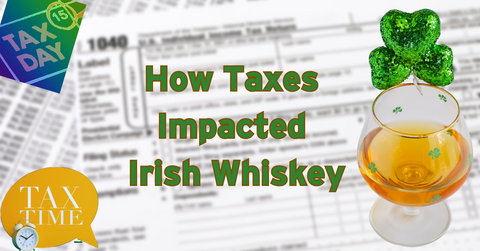How Taxes Impacted Irish Whiskey
Posted by Irish Whiskey USA on

Irish Whiskey and Taxes have a long and complicated relationship. April 15th is a day everyone knows and has marked on their calendars. Tax Day is dreaded by many, feared by some, and eagerly anticipated by a few refund seekers. Whatever your situation, taxes have had a profound impact on our lives, particularly if you enjoy Irish Whiskey. While you prepare your tax returns, hopefully with a full glass of your favorite Irish whiskey, realize how important the role of historical tax policy has influenced what you are drinking.
Poitin: The first known whiskey tax was likely instituted Christmas Day 1661 for 4 pence per gallon distilled. This led to evasion and the distinction of legal (parliamentary) whiskey vs. illegal poitin (pocheen).
Pure Pot Still: In 1682 the Malt Tax was instituted by England. This led to the Malt riots in Scotland in 1725; however, the tax was not imposed in Ireland until 1785. Despite this, records indicate that unmalted or "green" barley used in mash bills was a common practice in Ireland even before the implementation of this tax. Irish Whiskey marketing likes to claim that taxes directly led to the Single Pot Still style of whiskey we know and love today. This is probably more myth as one-third of mash bills contained unmalted barley before the tax. Whiskey makers learned that only about 30% malted barley was needed to get the necessary reaction in the process. Indirectly, the existence of the Malt Tax did likely solidify the continued and permanent use of unmalted barley in Irish Whiskey making given the expense incentive. Directly or indirectly, most will agree that the combination of both malted and umalted barley to create what we now know as Single Pot Still was probably worth any taxes.
Mash Bill: In 1759, steps were taken to limit the production of cheap and "impure" whiskey. The popularity of Irish whiskey had led to many producers pumping out volume without regard to quality. New rules required mash bills to contain only malt, grain, potatoes, and sugar. This had the desired effect by stamping out cheap product being called Irish whiskey. Another consequence was that many whiskey makers went underground, reducing the number of legal distilleries. In any case, the other significant impact of this change was the reduction in volume that could be taxed.
Stills: In 1779, Tax Reform was passed to make up for the lost revenue impact of the 1759 mash bill changes. Going forward, capacity was taxed rather than actual volume. The indirect impact of this was to affect the size and style of pot stills. It also made efficiency of paramount importance. Because tax was based on still potential capacity, how big the still was mattered in addition to how well it worked. Operating a still only part time became very costly. This change also forced more whiskey makers underground.
Distilleries: The number of legal distilleries dropped from 1228 to 246 by 1790, and to only 32 by 1821 due to the tax reform. Geography made a difference. Illegal whiskey making was very popular in rural areas of Ireland where it was easier to avoid tax collectors. Legal distilleries concentrated in Dublin and Cork where market demand allowed whiskey makers to be bigger and expand capital investment.
Quality: Illegal whiskey making was very popular throughout Ireland as tax avoidance flourished. In 1823 changes were made to curb illegal whiskey making. To make legal whiskey production more attractive, tax policy was reformed again. Taxes were cut in half and billed upon sale of whiskey rather than up front monthly. This directly led to improved quality of Irish whiskey. Taxes were no longer based on potential capacity or before whiskey was sold. Legal Distillers could now slow production, change pot still sizes and styles, as well as age whiskey for longer. After these changes, the number of legal distilleries in Ireland grew from only 32 to 82 in just 4 years.
Aeneas Coffey: One person may have had the biggest impact on Irish Whiskey indirectly from tax policy. Aeneas Coffey was the head tax collector for Ireland, travelling around the country touring distilleries. Along the way he was involved with many skirmishes in the western part of the country amongst the illegal whiskey makers. Before resigning in 1824, he had proposed many reforms to improve the tax collection policies for Irish whiskey makers.
Aeneas used his vast experience seeing whiskey making to perfect the column still. Often credited with inventing the still, Aeneas actually improved on pre-existing versions already in use. The rest as they say is history as the "Coffey" Still was not embraced by Irish distillers but instead popularized by Scottish competition. This technological change was a primary factor which led to the lighter style of whiskey from Scotland. Among many other factors, this development contributed to the rise in Scotch popularity and the corresponding demise in Irish Whiskey during the 20th century.
2023 Tax Policy: Ireland has the 2nd highest overall alcohol taxes in the EU with those on whiskey the 3rd highest to only Finland and Sweden. The excise tax on a bottle of Irish whiskey is currently around 12 euro. By comparison, it is less than 3 euro in Spain. Irish whiskey makers also have to contend with a 23% Value Added Tax (VAT).
Despite its importance for tourism, the Irish Government arguably does not make it easy for the burgeoning whiskey industry. Going forward, the more than 40 fledging whiskey makers will be impacted by the high tax burden. This will impact pricing on a bottle of Irish whiskey, methods of production, how long they can afford to age product, and future consolidation or partnership ventures.
